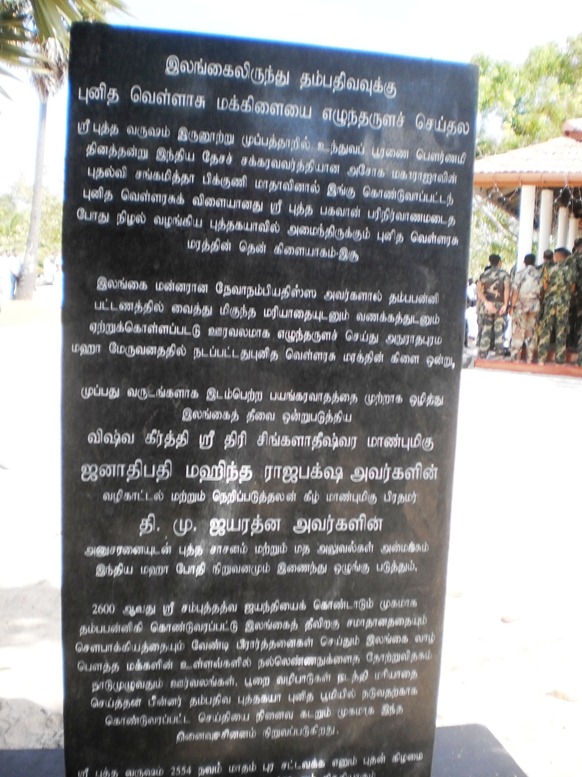The political and military connotations with which a sapling of the Bo tree at Anuradhapura was paraded in Jaffna on Wednesday, before presenting it to Bodh Gaya in India to mark the 2600th year of the attainment of Buddhahood, alienated Eezham Tamils of the land, smacked of consecration of the genocide against them and involved India as a party, commented a Jaffna university academic. A modern ‘inscription’ erected at Maathakal, Jaffna, to mark the occasion read in corrupt Tamil, that the sapling was brought to Dambapanni (a wrong identification) for peace and to create goodwill among the ‘Buddhists’ of the island, before presenting it to Bodh Gaya in Damba-diva [India], under the guidance of president Mahinda Rajapaksa, of ‘Universal Acclaim,’ Lord of the Three ‘Sinhala’ Countries [the island], who routed out 30 years of ‘terrorism’ and united the island.
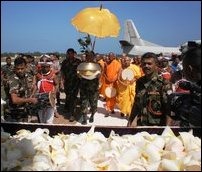 While Rajapaksa in the making of a new ‘dynasty’, titles himself in feudal style ‘Thiri Sinhalaatheeswara’ [the Lord of the Three Sinhala Countries] in his ‘inscription’ to imply that the entire island is a Sinhala territory, history is exploited to bring in symbols for New Delhi – Colombo partnered contemporary subjugation of Eezham Tamils, academics pointed out.
While Rajapaksa in the making of a new ‘dynasty’, titles himself in feudal style ‘Thiri Sinhalaatheeswara’ [the Lord of the Three Sinhala Countries] in his ‘inscription’ to imply that the entire island is a Sinhala territory, history is exploited to bring in symbols for New Delhi – Colombo partnered contemporary subjugation of Eezham Tamils, academics pointed out.
The message of the ‘inscription’, besides exploiting Buddhism to glorify the genocidal polity of the Sinhala state and Rajapaksa, in a nuance of expression also implied Indian partnership, by wording that the original Bo Tree was sent by the ‘Indian’ emperor Asoka (Inthiya theasa chakkaravarthi).
In the times of the Mauryan emperor Asoka there was no ‘India’ and Asoka never ruled the present day Tamil Nadu and Kerala states of India.
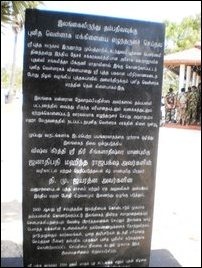 According to Buddhist chronicles in Pali language, the Bo-Tree sent by Asoka was received at the port Ko’la-patuna or Jumbu-Ko’la-patuna or Dambu-Ko’la Patuna, in the Naaga-deepa (Jaffna Peninsula).
According to Buddhist chronicles in Pali language, the Bo-Tree sent by Asoka was received at the port Ko’la-patuna or Jumbu-Ko’la-patuna or Dambu-Ko’la Patuna, in the Naaga-deepa (Jaffna Peninsula).
If what the Buddhist chronicles said after nearly 700 years of the event was true, then the Bo-Tree had come to a port town of the Tamils in the island, because the Pali form Patuna is clearly a rendering of Tamil/ Dravidian Pattinam, meaning a port town.
As could be seen in so many other examples, Ko’la here is another Pali corruption of the Tamil/ Dravidian word Kozhu, meaning a point in the landscape. Jumbu and Damba are interchangeable in Prakrits and they mean the tree Jumbosa vulgaris (Naaval in Tamil).
On the basis of believes, Ko’la-patuna is identified with present day Thiruvadinilai near Maathakal, which makes the corner point of the Jaffna Peninsula at its northwest coast.
The Rajapaksa inscription erected at Maathakal is wrong when it says that on the occasion remembered by the ‘inscription’ the sapling was brought to Dambapanni. That is another name believed to be the place where Vijaya of the Sinhala myth landed.
The ‘inscription’ in pathetically faulty Tamil, clearly indicates that no Tamil was involved in drafting the text.
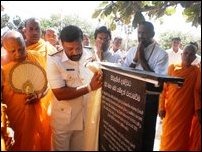 On the same day on Wednesday, Vasudeva Nanayakkara, the SL minister for ‘language and social integration’ was releasing a guidebook to teach Tamil to Sinhala officials and police.
On the same day on Wednesday, Vasudeva Nanayakkara, the SL minister for ‘language and social integration’ was releasing a guidebook to teach Tamil to Sinhala officials and police.
The book was brought out through the assistance of the Canadian International Development Agency.
"As the colonial SL government plans to rule the country of Eezham Tamils in the future, exclusively through Sinhala military and Sinhala civil servants, and as this model of permanent subjugation of Tamils in the name of ‘unity of Sri Lanka’ is blessed by many countries including Canada, let us hope that in future either Colombo’s language as seen in the Rajapaksa inscription improves, or Tamil improves by Sinhalicising itself," commented the Jaffna university academic.
The 2600th year of the Buddha attaining Buddhahood, or the 2364th year of the arrival of Buddhism to the island as claimed by Sinhala Buddhist establishments are not historically accepted facts.
They are based on Mahavamsa reckonings placing the life of Buddha from 623 to 543/ 544 BCE. According to this reckoning, the enlightenment of Buddha happened in the year of 589 BCE.
Most of the historians, worked on the chronology with the help of more objective evidences such as the subsequent inscriptions, placed the life of Buddha to 563-483 BCE. Some recent studies place the death of Buddha to 411/ 400 BCE.
According to Pali chronicles of Sri Lanka, the Buddhist emissary of Asoka came to the island in the 236th year of the Buddha Era (what point was taken as the beginning of the Buddha Era is not clear).
A previous Sinhala ruler of the island, Sir John Kotalawela as well as his opponent aspiring for power through evoking Sinhala-Buddhist sentiments against Tamils, SWRD Bandaranayake, also tried to politically capitalise the 2500 death anniversary of Buddha that fell in the year 1956 (according to Sinhala tradition).
The original Bo Tree under which Buddha is said to have attained enlightenment at Bodh Gaya in today’s Bihar state of India, doesn’t exist there now.
The tree that is found at Anuradhapura, which according to legend grown from a branch of the original tree brought by the Asokan emissary, is the oldest tree of literary record in world history. Many saplings have already been taken from this tree to Bodh Gaya where there is an orchard of Bo Trees now.
According to the military website of Sri Lanka, the present sapling will be taken to the official residence of Rajapaksa on the 14 February.
A special flight has been arranged to take it to Bodh Gaya for planting it on 17 February.
Both the Colombo government and the Maha Bodhi Society of India are taking the initiative.
The Maha Bodhi Society was founded in 1891, simultaneously in Colombo and Culcutta (the then capital of British India). Anagarika Dharmapala, the champion of Sinhala-Buddhism, who saw the Tamils of the island as ‘foreigners’, founded the society. Later, the British India as well as independent India bestowed the custody of major Buddhist sites in India into the hands of this Sinhala-Buddhist society operating in India.
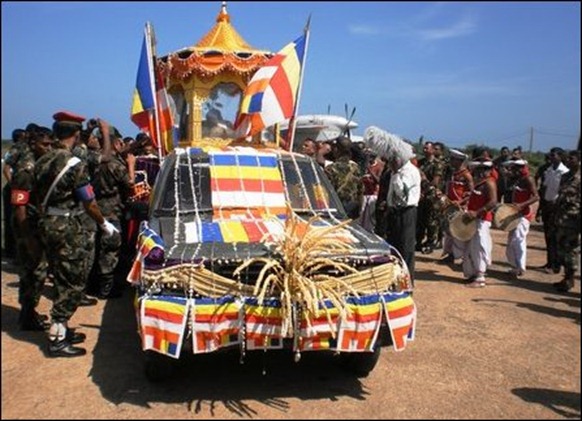
Starting from Palaali airport, the sapling was paraded to Jaffna through Palaali Road, from there went to Maathakal and then was brought back to Palaali before being flown to Vavuniyaa. Military’s security was oppressively tight throughout the peninsula.
The Tamil version of ‘Rajapaksa inscription’ in a pathetically faulty language.
TamilNet: 10.02.11 Colombo exploits Buddhism to consecrate genocide
(For updates you can share with your friends, follow TNN on Facebook and Twitter )

